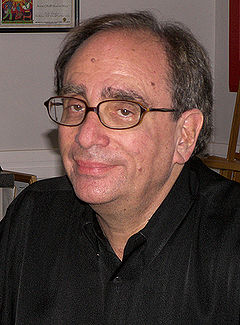¿Que te apetece leer?

 It is said that fear and laughter are the most difficult feelings to convey in books, but looking to your successful literary career it doesn’t seem a problem for you. What do you do to transmit that horror and humor to your books?
It is said that fear and laughter are the most difficult feelings to convey in books, but looking to your successful literary career it doesn’t seem a problem for you. What do you do to transmit that horror and humor to your books?
For me, there is a very close connection between horror and humor. Horror films always make me laugh--not scream. If you listen to people on a rollercoaster ride, you hear them laughing and screaming at the same time. These are visceral, basic reactions which I think are easy to get on paper.
Where does your fascination for fear and terror come from?
I think we all like to be scared--if we know we're safe at the same time. We like to have virtual creepy adventures. It makes us feel as if we have control over the scary things in the world. I was drawn to horror at a very young age by horror comics and movies. But as I say, they made me laugh--not tremble.
Teenagers have changed a lot. Now they aren't so easily scared as before, or are they? Do you think that, no matter how much time passes, the young people will continue to fear the same things? What are the major terrors that underpin you to develop your stories?
Technology changes. Some attitudes change. But the same fears remain. We are still afraid of the dark... afraid of being all alone in a creaky old house late at night... afraid something is lurking under the bed, waiting to grab us by the ankle.
What do you think of the current young adult literature, in which vampires and werewolves break hearts instead of scaring? Can we still find horror novels as before?
The romantic vampire books don't interest me as much as the frightening, violent vampire books. But they present a fantasy young people crave these days. And it always makes me happy to see young people reading.
You started to publish before all the current YA literature boom. How were your beginnings? How do you think the Internet and the Social networks have influenced the evolution of children's literature?
My first YA horror thrillers in the FEAR STREET series began in 1989. I'm happy to say that I created my own YA boom then. We sold over 80 million copies of Fear Street books. I think it's too early to say how social networks have influences children's literature. So far, I'd say, Not Much.
Which authors or books have influenced you most?
The sci-fi fantasy stories of Ray Bradbury. Isaac Asimov and other sci-fi authors. The horror comics of the 1950s. P.G. Wodehouse humorous novels. Agatha Christie.
You've worked -and still work- as film and television scriptwriter, producer, journalist... how has all that influenced your writing?
No, I haven't done a lot of TV work. I was head writer of a show for preschool kids. But I haven't written any scripts for my own TV shows or movies. I love to see what other writers do with my stories.
You have been defined as the Stephen King for teens, you have won numerous awards and you also appear in the Guinness Book of Records 2003 as the best-selling children's book series author of all time. How do you deal with such a great success?
It's all been a lot of fun for me. You have to remember that I wrote for 20 years before anyone noticed me! Most exciting are the millions and millions of kids who learned to love books from my work. That is the most thrilling part of what has happened in my career.
Why do you prefer to write for teens, instead of for adults? Do you think that adults and teens are very different among each other in their literary demands, especially for the horror genre? In what sense?
I love my 7-12-year-old audience. I get them to read my books at the last time in their lives they will ever be enthusiastic about an author. I have such close contact with my readers. Adults don't have time to write to authors. But kids really want to be in touch. It's the most wonderful audience!
Many of us grew up with the stories of Goosebumps, and if there was something they all shared (like many other books of your series) were those open-endings after everything seemed to be resolved. Why do you do this?
To be funny. Kids like my books for the twists and turns. I like to toss in one final twist at the end. One last little surprise.
An obvious question to a master of terror as you are: What was your biggest fear as a child? And now as an adult? Have you based any book in one of your nightmares?
Luckily, I had MANY fears as a child. I was a very fearful kid. I guess that's why I stayed in my room all the time, writing... writing. Luckily, today I can remember my childhood fears and shyness and awkwardness and use them all in my books. So I guess it turned out to be a good thing!











